Mouth- and teethproblems in Cats
By Lies Klösters, 2006
Humans and animals can develop all sorts of tooth problems. The problems that occur mostly in humans (caries under the influence of sugar) don't often occur in animals because most animals eat much less sugar than humans do. Still, your pet could develop tooth problems. A single check-up will tell you if the animal has a good alignment of its teeth, if all the teeth are present, etc. Regular check-ups of older animals can prevent tartar (calculus) and plaque build up: it can be removed in an early stage before causing problems. But also diseases like gingivitis can occur at any age. In short: a good tooth check-up is very important to detect possible problems in time.
Types of teeth
All animals have teeth that are perfectly adapted to their food and lifestyle. Some species of animals have teeth that are all shaped more or less the same, like sharks, crocodiles and many toothed whales (see figure 1). These are called homodont teeth. Most mammals are heterodont and they have several sorts of teeth: incisors, canines, premolars and molars (see figures 2, 3 and 4). Some animals have teeth that are very specific for their species (like the fangs of poisonous snakes, or the tusks of elephants, walruses and narwhales), others have teeth that we find in larger groups of animals. Mammals can roughly be divided in 3 groups that live of different types of food, namely:
- herbivores (plant eaters) with flat molars for grinding (figure 2)
- carnivores (meat eaters) with sharply edged premolars and molars (figure 3)
- omnivores (eats both meat and plants) with teeth that are shaped somewhere in the middle of the carnivores and herbivores (figure 4)
 |
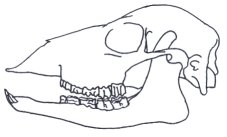 |
| figure 1: teeth of an orca |
figure 2: teeth of a roedeer |
 |
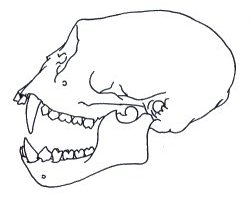 |
| figure 3: teeth of a cat |
figure 4: teeth of a gibbon |
Feline teeth
The cat is a carnivore. Carnivores have sharp, slicing teeth; teeth that are designed for catching, holding and tearing up a pray and if necessary biting through bones. Most of them cannot chew their food: their jaws can't move from left to right, only up and down.
Cats and dogs are born without teeth just like humans; they have their first teeth -milk teeth- after they are several days old and these will be changed for the adult teeth after several months. The teeth of cats and dogs do not continue to grow like the teeth of some rodents, horses or elephants.
The composition of the teeth can be expressed in a dental formula. The dental formula consists of two lines underneath each other, for the upper and lower jaw. The formula then describes half of a jaw, since the left side of the jaw is identical to the right side. (As long as all teeth are still present.)
The abbreviations in a dental formula stand for: I = incisor, C = canine, P = premolar, M = molar. These abbreviations in small letter mean milk teeth, capital letters mean adult teeth. The dental formula of cats is:
| milk teeth: |  |
adult teeth: |  |
At the age of 11 to 15 days, the teeth of the kittens erupt and when the kittens are 37 to 60 days old the milk teeth are complete. The milk teeth are replaced with adult teeth at the age of 13 to 24 weeks.
The replacing of milk into adult teeth happens in a fixed order:
- I 13 - 16 weeks
- C 20 - 24 weeks
- P 20 - 24 weeks
- M 18 - 24 weeks
During the teething period it is possible to give a fairly accurate estimation of the age in case you ever need to do so for a foundling.*
Occlusion of the teeth
A correct alignment of the teeth is called a "scissor bite". When the teeth are not placed correctly, we speak of "malocclusion" and then the alignment is for example named overbite, underbite, level bite or crossbite.
- Scissor bite: the lower jaw should always be slightly smaller then the upper jaw. The ideal set of teeth consists of incisors in the upper and lower jaw that fit exactly over each other, and molars that fit on top of each other.
- Overbite: the incisors of the lower jaw are placed to far behind the incisors of the upper jaw.
- Underbite: the incisors of the lower jaw are placed in front of the incisors of the upper jaw.
- Level bite: the incisors are place on top of each other, instead of fitting correctly over each other.
- Cross bite: or 'wry bite' or 'wry mouth', this means that the left- and right half of the jaw are not of the same length.
The composition of the teeth in dogs is included in every breed standard. The breed standards of cats do not always describe what the teeth should look like. Sometimes it is noted in a breed standard that an overbite can not be more than 1 or 2 mm of space between the upper or lower jaw, in other standards it says that the cat may not have an overbite or underbite.
During the dog shows the judges check the teeth of each and every dog, a wrong set of teeth results in immediate disq. The judges in cat shows only look at the teeth if they can see 'from the outside' that something is wrong. At FIFe shows the judges are allowed to look in every cat's mouth (which doesn't mean that every cat has their teeth checked on such a show), other cat associations don't even allowed looking into a cat's mouth, or only after the judge has asked permission from the owner to do so. This rule has been established by some of the cat associations because of the risk of spreading diseases. Of course they have a point there: the cat's mouth is full of bacteria. (This is also the reason why a cat's bite will much more often lead to inflammation than a dog's bite.) But the lack of this standard check as a part of the judging protocol also means that there is little to no professional insight on the alignment of the teeth and jaws.
We should note here that cats do not necessarily cooperate willingly to a mouth inspection, unlike dogs who can be trained for this quite easily. When the cat's teeth are checked at a show and something is not right, this should entail disqualification, the same as it is for dogs.
Dogs with very narrow muzzles sometimes miss one or more incisors. In breeds with very short muzzles sometimes molars can be absent. For dogbreeds with a medium to long muzzle the breed standard usually says that a scissor bite is the best, but that a level bite is also allowed. A lot of underbites can be seen in dogbreeds with very short muzzles, this is also noted in their breed standard. All kinds of problems can be caused by a too large space between the jaws (in an under- or overbite) because the teeth don't close properly. For instance during birth where the bitch can't get the pups out of the amniotic membrane by herself because she can't catch the membrane between her teeth. When a bitch with a large under- or overbite has her puppies without human assistance to take the pups out of their membranes, the pups will suffocate a few minutes after they are born.
The various catbreeds are physically not so diverse as dogbreeds, especially the differences in body sizes are tiny. But the shape of the head is different particularly in those breeds that have been bred for extreme appearances over a longer period of time already. Long muzzles can give overbites, but these overbites are usually not so big that they cause problems. As described above, short muzzles do give problems regularly. That is why especially catbreeders who work with breeds with short muzzles must pay a lot of attention to not developing the same problems as we see in dogbreeds with short muzzles. Some cats (including the cats with long or medium muzzles) have problems with cheeks of different lengths, wrongly placed canines or crossbites. By making a good and thorough selection in the breeding animals, breeders can make sure that these problems do not show up in large parts of the population, but that they remain exceptions.
Plaque and tartar
Bad breath and drooling can be some of the first signs of a problem with your pet's mouth, in a later stage this could evolve into refusal to eat (especially if the food consists of a hard type of food) as the gingiva would be causing pain. As the gingiva can start to bleed, the animal might rub its mouth with its paws and cats sometimes don't want to groom themselves anymore. Gently lift your pet's lip en check the mouth for plaque, tartar, inflamed gingiva, and lost or broken teeth.
Most problems start with plaque. Plaque can be found on the edge of the teeth and the gingiva, and contains a lot of bacteria. After a while the plaque hardens into a brown layer that covers the teeth: tartar. Tartar can cause a number of problems such as inflammations and bleeding of the gingiva, decaying teeth, loosened teeth which might fall out or that have to be removed. If tartar remains on the teeth too long the inflammation of the gingiva can develop into gingivitis (swelling, inflammation and bleeding gingiva). The bacteria from the tartar can even end up in the cat's blood circulation and affect the health of your cat by causing inflammations in the kidneys, the heart valves and the discs in the spine.

scaler
With a scaler (available on the Internet or from your vet or dentist) tartar can be scraped off. You can do this yourself or you can have it done by your vet. For dogs it also helps to give them bones: the action of chewing the bones scrapes the teeth clean. Some cats also enjoy chewing bones, but not every cat will do this. Never give cooked but always raw bones to your dogs and cats: cooked bones are softer and splinter easily. The bones shouldn't be too small, the dogs (or cats) could then swallow them and choke.
Some animal food manufacturers have looked into these problems and they adjusted their food accordingly. This resulted in different brands of dry food with large, hard pellets that are too big to be swallowed whole by the cat. These pellets should remove plaque and tartar of their teeth while the animal bites through the pellets. It helps a bit, but it is not enough to keep the cat's teeth clean. (If you do feed your cat dry food, make sure there is enough drinking water available.)
Brushing the cat's teeth gives an even better result in getting rid of the plaque and thus avoiding the growth of tartar, although this is not always easy to do. The cat really has to get used to this but it is not impossible to introduce this as a new routine. Especially if they receive a small reward after the brushing like a bit of the special for them developed toothpaste (do not use toothpaste that is made for people!) they will give in to your wishes.
Gingivitis, periodontitis and stomatitis
If the gingiva is red, swollen, sensitive and bleeding easily, it is called gingivitis. This can happen to cats of all ages. Gingivitis can be caused by tartar but it can also occur spontaneously when the teeth are very well taken care of. There are a lot of theories about the causes of this spontaneous occurring gingivitis. The opinions on the treatment are equally diverse.
The first sign of gingivitis is a thin red line along the teeth in the gingiva. In this stage the process can be stopped -especially when caused by plaque or tartar- by cleaning the teeth thoroughly. The inflammation in the gingiva will disappear without damage to the teeth.
When gingivitis has progressed it can also affect the bone underneath the gingiva, this condition is called periodontitis. At that stage the gingiva will start to grow rapidly and the teeth might not be saved (either they fall out by themselves or will have to be removed). Periodontitis is not reversible as gingivitis is. So it is very important to keep the situation under control and not to let it progress any further.
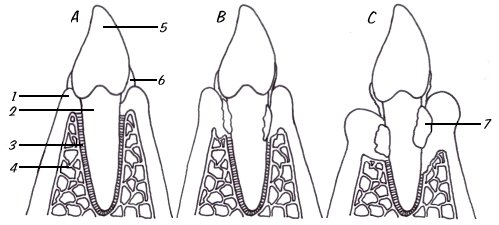
| How periodontitis starts. 1=gingiva, 2=root, 3=cement, 4=jawbone, 5=crown, 6=plaque, 7=tartar. A = The first formation of plaque. The gingiva starts to draw back a little bit. B = Underneath the gingiva tartar has built up. The gingiva is irritated and swollen. The tooth is less firmly fixed in the jawbone. C = The gingiva has a severe inflammation and is swollen badly. The tooth is almost loose from the jawbone and will soon fall out. |
Sometimes not only the edge of the gingiva around the teeth is inflamed, but also the mucous membrane in the entire mouth. This is called stomatitis. Cats with this disease often drool a lot and they almost or entirely stop eating because of a painful mouth.
It isn't clear yet what causes gingivitis, periodontitis en stomatitis. There are several theories about these diseases, e.g. a reaction of the immune system to the bacteria in the mouth or an autoimmune reaction. With some cats, the diseases starts when they are at a vulnerable stage, like a female who just had kittens, or animals who are sick or who just had their yearly vaccinations. There are also indications that there could be hereditary factors involved, especially when the parents and/or grandparents of the affected cat also had this same condition. Unfortunately no research has been done yet that was able to point out exactly what causes these diseases.
The hereditary form of these diseases seems to be the hardest one to treat, in a lot of the cases the teeth have to pulled because the inflammations can not be controlled. As soon as the teeth are removed and the plaque and the tartar is gone, the cat won't suffer from the inflammations anymore.
For cats with the non-hereditary form of these problems, antibiotics or brushing the teeth can be a solution, but even here one can not always avoid removing the teeth. In all cases it is good to keep a close eye on the quality of life of your cat, and adjust the treatment to that (in consultation with your vet of course!).
Feline Oral Resorptive Lesions, or FORL
This disease affects mostly cats that are older than approximately 4 years. Other names for this defect are: cavities, external or internal root resorptions, cervical line erosions or neck lesions.
Affected teeth will develop lesions in the roots of the teeth. This is extremely painful. Therefore some of the signs for this disease are: drooling, bleeding from the mouth, and signs of pain when the mouth it touched. Also, the cat will show hunger, run up to its food, but will drop the food or won't start eating at all. Affected teeth almost always have to be removed, because there is no cure for this disease. FORL is a progressive disease, which means that even after all the affected teeth are removed from the cat's mouth, the remaining teeth might develop the same symptoms.
FORL is not something that can always be diagnosed at first sight or a quick glance, a cat with teeth that appear to be perfect can still have FORL. Tartar and plaque are not the causes of FORL. Only a x-ray can show what is happening under the surface of the gingiva.
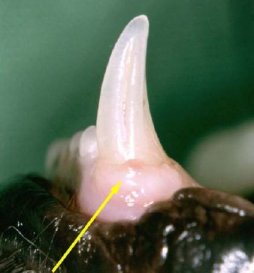
This picture showes a canine with a small, hardly notable patch of the mucous membrane on the edge of the gingiva.
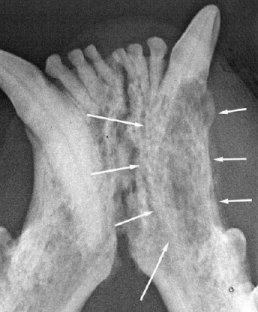
The x-ray picture shows that the little patch of the mucous membrane is only the tip of the iceberg: the root of the canine is almost completely dissolved. (See arrows)
Photo credit: Dr. Markus Eickhoff **.
IMPORTANT: If your cat has serious mouth- or teethproblems, please take your pet to a veterinarian who is specialised in dentistry!
Literature reference:
* Tandheelkunde bij hond en kat, Dr. Leen Verhaert, Dipl., E.V.D.C.
** FORL – Die neue Geißel der Katze, Dr. Markus Eickhoff.
